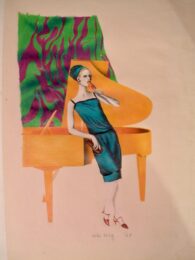

English draughtsman, printmaker, sculptor and painter. He studied first at Norwich Art School, where he was much impressed by Michael Andrews, with whom he remained friends. In 1961 he entered the Slade School of Fine Arts in London, where he remained until 1963 despite the vilification that he received for his work from those around him; the visits and encouragement he received at this time from two older artists, David Hockney and Peter Blake, gave him the confidence to continue concentrating on the production of small drawings and collages of great intensity. One of his rare large paintings, Two Waiting Women and B-58 Nuclear Bomber (oil on board, 1.22×1.82 m, 1963; London, J. Moores priv. col., see 1997 exh. cat., p. 177), portrays two fashionably dressed young women silhouetted against a broad expanse of lightly clouded sky whose peacefulness is broken by the sudden intrusion of a nuclear bomber.
Convinced that the natural aggressive tendencies of humanity, combined with advances in technology and Cold War politics, would soon result in the annihilation of the planet, he produced strikingly original works such as the pencil drawing Guard Dog on a Missile Base No. 1 (1965; London, Tate) and the sculpture Leopardskin Nuclear Bomber No. 2 (1963; London, Tate). The latter is part weapon, part phallus, part animal predator. He addressed similar imagery in equally original prints such as Bomber No. II (1964; London, priv. col., see 1997 exh. cat., p. 174), creating the image by inking up a number of separate found metal plates placed side by side; his radical redefinition of etching was manifested also in his decision to produce a small number of unique variants of each print, rather than a uniform edition.
In 1965, the year in which he produced some of his most celebrated works—such as Cinema 3 (1965; London, James Kirkman Ltd., see 1997 exh. cat., p. 178) and other collages representing female models inside Art Deco cinemas—Self introduced a new range of subjects as a result of a trip to the United States. One group of drawings made that year, the Fall-out Shelter series, continued the theme of imminent nuclear destruction, this time featuring women in an often sinister urban environment always featuring the signs for nuclear shelters that had made such an impression on him when walking along the streets of New York. Others featuring apparently innocuous motifs from contemporary life and consumer society, such as Hot Dog No. 3 (1965; artist’s priv. col., see 1997 exh. cat., p. 176), again conveyed an unexpected atmosphere of violence and sexual threat; the characteristic technique used in such drawings, so densely worked in black and coloured pencils that they take on a relief-like quality, gives them a haunting intensity that was much admired by other artists. His intention was to produce a detailed record of his society which, in the event of its destruction, would convey its essential qualities to anyone coming across his work in the future.
Deeply suspicious of the commercial art world and wishing to protect himself from exploitation, in 1965 Self returned permanently to his native Norwich and continued to work in isolation while remaining friendly with such artists as Blake, Hockney and the sculptor Clive Barker. Both his subject matter and his repertoire of techniques continued to expand, taking in atmospheric Norfolk landscapes, still lifes and quirky observations of human behaviour. He continued to invent unusual procedures, as with Man Scanning the Distance (1984; London, Tate) and other sculptures cast in liquid concrete from moulds produced by tunnelling into damp sand with his bare hands. In 1995 the Tate Gallery in London presented a display of their entire holdings of his work, more than 50 pieces in all including an important group of drawings, sculptures, paintings and prints acquired in the preceding years directly from the artist.
A retrospective of his work entitled ‘Colin Self: Art in the Nuclear Age’ will be held at Pallant House Gallery, Chichester (21 June -12 October 2008) and will be curated by the art historian Simon Martin. There was also a small commercial show of 1960s works at the Delaye-Saltoun gallery in London (20 June – 1 August 2008).